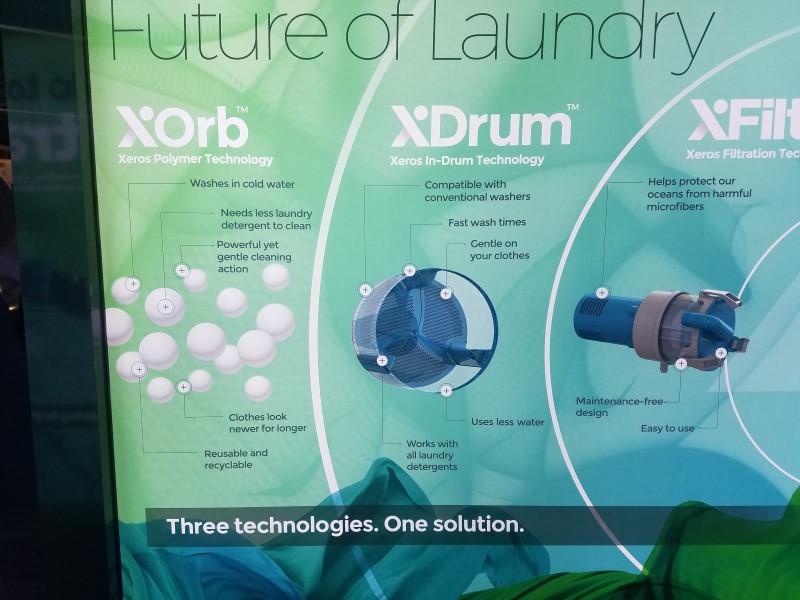 |
Another year, and another CES in the bag. As in previous years, here are notes from my visit.The usual caveats apply: This is simply a collection of random things I encountered from my visit. I don’t claim this to be comprehensive review, nor an un-biased one. This year I spent about a day and a half at show split between the main convention center and the Sands Expo center. |
The usual caveats apply: This is simply a collection of random things I encountered from my visit. I don’t claim this to be comprehensive review, nor an un-biased one. This year I spent about a day and a half at show split between the main convention center and the Sands Expo center.
My time at the show was cut a little short because of an unexpected power cut. All the power went out in the main exhibition hall (where I was at the time), and the South Halls. (The cause of the outage, I discovered later, was fallout from the extreme rain the day before which caused issues with a transformer). The power was out for just less than two hours. During this time, I camped out at the Canon booth, where I was when the power went out. It just happened that the lights at the Canon booth stayed on (no outlets), despite the lighting on every other stand going out. I can only presume that Canon had a battery backup system (either this or the lighting for just the one booth was being fed power from another, unaffected, circuit). Anyway, thanks Canon!

The irony of this power loss at the Consumer Electronics Show was not lost on the World, and the event made national news. Social media also lit up. If I had a dollar for every comment I read from people who suggested that people should stop running around the halls saying “Alexa, turn off all the lights!”, I’d probably be able to retire.
Digital Assistants The comment about “Alexa, turn off all the lights!” was very relevant; if there was a theme of the show it was that voice control, and digital assistants are here to stay. If there was a competition at the show for marketing of these devices, Google was the clear winner. Google Assistant “Hey Google” branding was everywhere at the show (and all over the rest of Vegas), including plastered all over the monorail.
Amazon Alexa branding references were harder to spot, but if you looked you might have seen a couple of mentions. Totally missing was any mention/reference to Siri (Apple), or Cortana (Microsoft). In fact, significantly more coverage at the show came from a fifth horse in the race, Samsung’s Bixby.

Apple have traditionally done their own thing, and snubbed CES, but this is a year seems to be pivotal one, and maybe they’ll regret it. There’s a war going on for voice assistants. Now that voice control technology is pretty mature and reliable, it’s going to be the natural interface for many homes. These devices are not just voice portals to the internet, they are the nexus for the smart home. Control of the living room is going to be everything. It’s a composite strategy needed for success in this category: It’s not just the AI and smarts of the assistant (and the cloud), it’s the hardware too, and it’s interfaces with the rest of the home …
If we’re to believe all the hype then pretty soon every device one cares about in the house will talk to us, and will take it’s input from voice. It’s going to be an uphill battle for Microsoft to catch up against the leading three (Amazon, Apple, Google), who already have, not just mind share of the assistant component, but also significant hardware and smart home interface devices and partnerships). At least Samsung already has a lot of the hardware part of the equation to keep it in the game for now.
TVs
| |It’s not CES without big-ass TV’s, and this year was no exception. But, I have to say, the importance of TV’s seems to be getting smaller each year. All the TVs that were on display looked beautiful (as they should). Some were 8k (mostly up-scaling lower resolution sources, but there were a couple of native 8k sources), and the contrast of the displays were stunning. LG always puts on a great display and this year was no exception with a walk-through tunnel of a couple of hundred panels (all of them curved, a mixture of convex and concave screens).|
|It’s not CES without big-ass TV’s, and this year was no exception. But, I have to say, the importance of TV’s seems to be getting smaller each year. All the TVs that were on display looked beautiful (as they should). Some were 8k (mostly up-scaling lower resolution sources, but there were a couple of native 8k sources), and the contrast of the displays were stunning. LG always puts on a great display and this year was no exception with a walk-through tunnel of a couple of hundred panels (all of them curved, a mixture of convex and concave screens).|
All of the TV’s I saw were thin. Some of them were curved, and one even rolled up like a yoga mat (why?!?!). All boasted a collection of acronyms describing their unique picture technology, and how it was better than everyone else’s unique picture technology. One TV even had Google Assistant baked in!
Some of the pictures were so crisp that you had to do a double take if they were screens or photographs.
The most impressive TV I saw was Samsung’s Wall. This was constructed out of microLED modules plugged together (pretty seamlessly) to make a giant wall. I believe the one I saw had an equivalent size of 146”. It was pretty stunning.
The giant screen at Sony’s booth was pretty spectacular too. Whilst I’m sure they’d probably sell you one if you asked, I’m not sure, however, that I’d call it a piece of “Consumer Electronics”.

It’s not just TVs. LG showed the first 21:9 5k Thunderbolt display. That’s quite a desktop.

There was a concept for an “enhanced” sports viewing experience from Panasonic using intermediate glass screens onto which were projected collimated additional content about the game and stats. It was a nice concept, but there was no head tracking so superimposed images might not match up. In the end, if people elect to go down this path, I suspect the solution will be mixed VR glasses that will augment whatever you are looking at and track your head movement. It’s probably cheaper, easier, and more flexible than having a dedicated projector for each person in the stadium.

Jet Pack
Maybe you’ve seen some of the internet videos of a man with a “Jet Pack”. I met the guy today. He’s built a pack that uses six small gas turbines to generate enough thrust to lift him up and propel his through the air. The pack weighs 97lbs and it attached with a multi-point harness. The engines spin about 80,000 rpm and burn a fuel-oil mix that both lubricates the bearings and is burned. The throttles control fuel pumps which determine the rate fuel is delivered.
Cars, cars, cars
I made a prediction a couple of years ago that automobile industry is going to change more in the next dozen years than it has over the last fifty years. The transformation is is happening even faster than this! Autonomous vehicles are not tomorrow’s world, they are here today. Those that are not self driving are offering driver assistance. For these reasons, car dashboards are are probably peaking in their utility. Because there still sometimes could be a warm body in the loop, this body needs GPS navigation screens, and car instruments, and vehicle status. In the future, however, dashboards will be relegated towards showing content, not vehicle performance.
As long as their is a steering wheel in the car, there is going to need to be an instrument dashboard. As soon as that wheel goes away, so will the driver’s dash.

If there’s another prediction about the future of cars it’s that all vehicles in the future will be white! (I say this tongue-in-cheek, but practically every concept car I saw at the show was white). I guess white cars look clean, futuristic, moddern, and bright. Even the self driving truck on display was white!
In previous CES reports I commented that today’s autonomous vehicles have “more processing power than a wheelbarrow full of Xboxes”. NVDIA were showing off devices that were, quite literally, super computers the size of licence plates! They were using the phrase “The World’s First Autonomous Machine Processor”. Skynet here we come …
Robots
Nikon attached a couple of nice cameras to some fast moving robots and invited attendees to dance as these things whizzed around. The cameras were panning and tilting so rapidly and capturing frames at a rapid rate so that, when the video was slowed down, the slo-mo effect had a “Matrix Cam” feel about it.
Omron showed a ping-pong playing robot. It was pretty big, and fun to watch.
| ||
|
||
| |In your best Crocodile Dundee voice: “Nah mate, that’s not a robot … this is a robot!|
|In your best Crocodile Dundee voice: “Nah mate, that’s not a robot … this is a robot!|
Remote Charging
I hate cord clutter. It’s a real pain having to plug devices in to recharge (and it’s even more pain to run out of power). Plus there is the anxiety that you might run out, so throughout the day you keep a weather-eye on your current battery status, and top up when you get chance. It’s a pain to have to carry around that cable and a wall-wart, and even when you’re at your own desk or home, it’s just a hassle to plug it in.
For these reasons, I’m excited by the convenience of wireless charging. I am, however, a little scared at the technology that claims to beam power directly to my phone when it’s still in my pocket. Tracking my phone in real-time and beaming it microwave energy of sufficient power to charge the phone is scary. There’s too much to go wrong, and I would not trust a third party to set theirs up correctly, even if I set-up mine correctly.
But we don’t really need that level of technology. All we need are wireless charging pads. The pain I hate is plugging in the cord, getting it tangled, and/or having to carry cords with me wherever I go. Fast forward to the future, I’m hoping everywhere will have little charging pads built into things: At the coffee shop, restaurant, bar, airport, station, library … ubiquitous locations I can just plop my phone onto for a quick top-up to help me through the day. Perfect!
We have free WiFi now in most retail areas consumers visit. Internet access is a utility. We should have free charge points too!
I’ll have a charge point by my desk, so when I sit down, I’ll plonk my phone there whilst typing. I’ll have one on my bedside table to charge my phone overnight. I hope meeting rooms will have them, and Starbucks. This near-field charging technology is good enough. It’s all you need to cut the charge cord.
One the design award winners at the show was demonstrating an alternate wireless power system that used Infra Red light to transmit power. This certainly sounds less scary that microwave energy.
I don’t think, however, that it solves any convenience problem. As IR is blocked by fabric, I’d have to take my phone out of my pocket and place it pointing towards a source. It also, currently, requires an external case with a receiving element, whereas the near field loops are already built into phones/batteries. If I’m taking my phone out of my pocket and placing it under a “heat lamp”, I might just as well place it on a charge pad. I’m also not convinced that with that small a receiver on the phone that I’d get enough power other than the to trickle charge my phone.
It’s a cool technology demonstrator but I don’t think it will scale to consumer electronics. The inventors were pretty coy about the technology and wavelength used, but considering it was not interfering with the camera in my cellphone, I’d speculate that it’s longer than 900nm wavelength.
| |There was another, much lower power, microwave charging system that caught my eye. This operated at 915 MHz, but significantly lower power output. They had a couple of dipole antennas on PCBs that were able to pull in just enough power to light a small LED. I can see some utility in this for devices like remote controls, or game controllers, that are left on the couch, unused and unloved, for the majority of the time.Super low power microwave energy could be used constantly trickle charge remote batteries so that they always have power and means that batteries never need to be replaced. It’s not a cost benefit (when was the last time you replaced the battery on your TV remote?), it’s more a convenience factor of not having to search and find a fresh battery for your remote when it dies.|
|There was another, much lower power, microwave charging system that caught my eye. This operated at 915 MHz, but significantly lower power output. They had a couple of dipole antennas on PCBs that were able to pull in just enough power to light a small LED. I can see some utility in this for devices like remote controls, or game controllers, that are left on the couch, unused and unloved, for the majority of the time.Super low power microwave energy could be used constantly trickle charge remote batteries so that they always have power and means that batteries never need to be replaced. It’s not a cost benefit (when was the last time you replaced the battery on your TV remote?), it’s more a convenience factor of not having to search and find a fresh battery for your remote when it dies.|
Super low power microwave energy could be used constantly trickle charge remote batteries so that they always have power and means that batteries never need to be replaced. It’s not a cost benefit (when was the last time you replaced the battery on your TV remote?), it’s more a convenience factor of not having to search and find a fresh battery for your remote when it dies.
Environment
Humans can be pretty destructive to our planet. You may have read about plastic microbeads and how toxic they can be.
Microbeads of plastic are so fine, they are not filtered out in water treatment. They are passing into the ecosystem. They are now banned from cosmetics in many countries.
There’s another source of potential pollution, and this is microfibres that get washed off our clothes during laundry (many clothes today are manufactured from synthetic materials and fleeces: acrylics and polyesters). It’s estimated that one million tons of these tiny fibres are discharged into waste water each year! These don’t break down and get ingested by living things! yugh!
Xorb, was demonstrating a couple of technologies to reduce impact to the environment. The first was pretty simple: a centrifugal filter in the waste water discharge from the washing machine to capture these fibres. If they could persuade every washing machine manufacturer to install a filter in the waste water line of all their machines, just imagine how much plastic we could capture each year and not pass into our drinking water. Good luck on your mission! If I could buy a machine with a filter, I would.
Their second idea was a method to reduce the amount of detergent needed in each wash. This is done by, in addition to the clothes, in the wash goes a handful of pea-sized beads (made of nylon), these rattle around with the clothes, increase surface contact and lathering, and working like a army of tiny little washboards spinning around with the clothes. The system they were showing was an automated way of getting them into the wash load, and extracting them at the end.

Smart everything
I thought we’d reached peak neuroticracy (is that a word?) last year in connected everything, but the trend continues; be it smart socks, smart bras, smart beds, spoons, frying pans, water bottles, washing machines … I breezed past most of them, but some I just had to comment on. See below for the “Internet of (pointless) Things”.
One manufacturer had a dashboard up with real time stats telling the world how many connected washing machines they were currently capturing data from. There was a even a pie chart showing the breakdown on the types of load. I could actually watch, in real time, the number of people washing underwear on the planet at that time. My life will never be the same.
| |Do you want to know what “Brain Sensing Eyewear™” does?Well, according to the booth staff, it plays “peaceful weather sound to you when you are calm”, and gives “instant feedback on your brain’s level of activity”. So now you know.|
|Do you want to know what “Brain Sensing Eyewear™” does?Well, according to the booth staff, it plays “peaceful weather sound to you when you are calm”, and gives “instant feedback on your brain’s level of activity”. So now you know.|
Well, according to the booth staff, it plays “peaceful weather sound to you when you are calm”, and gives “instant feedback on your brain’s level of activity”. So now you know.
Internet of pointless things
It seems that each year I make fun of totally silly devices. This year is no exception. Just because you can connect a device to the internet, does not mean you should. Making a device “Smart” or “Connected” should provide an advantage.
On display was a connected shower. You could turn it on and off with your smartphone. Why? What possible advantage is there to be able to turn the water on or off from your phone as opposed to the spigot that’s already in the shower? If I’m going to have a shower, I’m already there.! There is no need to do this remotely. And don’t tell me it allows you to control the temperature. If I’m in the shower and it’s too cold, I adjust the temperature from in the shower by turning the temperature knob. I don’t want to have to get out of the shower, fire up the app, dial in a new temperature and get back in. It’s as useless as a remote toaster. When I’ve finished showering, I can turn off the water from inside the shower. I don’t need to exit the shower (leaving the water running) to swipe my wet fingers over a smart phone to turn the water off again!
A possible claimed advantage is that you could remotely pre-start the shower so that it’s “up to temperature” by the time you wanted to get in, but this is wasteful of water, plus does not give you instant gratification of having shower on demand. I did not ask the price of this connected shower technology, but I bet it wasn’t cheap. Instead, at home, in my house, I have a small circulation pump that constantly circulates the warm water around. Whilst it might sound wasteful of energy, actually it saves a lot of water (and energy). I turn on the tap, the water is instantly hot. Nobody in our house turns on a tap, then walks out of the room leaving the tap running and waiting for the water to run warm (which is hard to predict; wasting much water, and energy, as people overestimate the time it takes for water to get warm).
Save your money. Don’t buy a connected shower, and instead invest the money in putting in a hot water circulation pump. You’ll thank me. Instant hot water all over your house.
 |
Here’s the World’s first connected shaver. What does it do you ask? Well, it pairs with your smartphone to record your shaving activity (I don’t know about you, but up until now I’ve had to record the duration of my shaving manually, and transcribe this, when I could remember, into a spreadsheet that I could then save in the cloud. This is going to revolutionize my morning routine!)The booth staff said it did more and that I could customize and build an individual shaving profile to match my skin. When I asked what it did, the demonstrator said that based on my inputs it could adjust the rotation speed of the heads. (He also went on to claim that it could configure other parameters of the shaver too and waffled about controlling the torque and “angle of the blades” in the cutting head; both of which sounded more interesting to me, but when pressed had no more details, and closer examination of the shaver revealed it looked just like a regular shaver - I think that was a bluff). |
The booth staff said it did more and that I could customize and build an individual shaving profile to match my skin. When I asked what it did, the demonstrator said that based on my inputs it could adjust the rotation speed of the heads. (He also went on to claim that it could configure other parameters of the shaver too and waffled about controlling the torque and “angle of the blades” in the cutting head; both of which sounded more interesting to me, but when pressed had no more details, and closer examination of the shaver revealed it looked just like a regular shaver - I think that was a bluff).
Desperate to sell me on the concept, at the risk of losing me on the pitch, he described the motion tracking built into the shaver giving constant feedback that I’ve shaving “correctly”. Electric shavers work best if you move them in a swirling motion (not just up and down), so it has a sensor to detect the swirl. I’m sorry, but I can learn that from a video, or reading an instruction manual once. Teach me once, and I’m good for life. If you’re the kind a person that needs constant reminder how to use a shaver once taught, I hope you never get behind the wheel of a car, or step on an escalator.
| |A product getting a lot of press coverage was clever wine stopper from Corovin. Rather than opening a bottle of wine, drinking only a glass, then allow the opened wine to oxidise and spoil (wasting it), this device has (what looks like) a sharp hypodermic needle that is pushed through the cork and into the wine. Pressurized inert gas (Argon) is then introduced into the bottle allowing the wine to flow out. When as much wine as needed is poured, the entire device can be pulled out of the bottle. The malleable cork then seals around the hole, keeping the air out and the wine fresh.So far so good, and I can appreciate the science behind this. I’m not sure I’d spend $1,000 for the device (the MSRP), but then again, I’m probably not the target audience.The reason for inclusion in this category, is that they made it connected. Why? What value does this add? Marketing staff are keen to sell you on the idea that it allows you to pair wine with music that goes well with it, for the experience. Sorry, I’m not sold. This part of it is just a gimmick.|
|A product getting a lot of press coverage was clever wine stopper from Corovin. Rather than opening a bottle of wine, drinking only a glass, then allow the opened wine to oxidise and spoil (wasting it), this device has (what looks like) a sharp hypodermic needle that is pushed through the cork and into the wine. Pressurized inert gas (Argon) is then introduced into the bottle allowing the wine to flow out. When as much wine as needed is poured, the entire device can be pulled out of the bottle. The malleable cork then seals around the hole, keeping the air out and the wine fresh.So far so good, and I can appreciate the science behind this. I’m not sure I’d spend $1,000 for the device (the MSRP), but then again, I’m probably not the target audience.The reason for inclusion in this category, is that they made it connected. Why? What value does this add? Marketing staff are keen to sell you on the idea that it allows you to pair wine with music that goes well with it, for the experience. Sorry, I’m not sold. This part of it is just a gimmick.|
So far so good, and I can appreciate the science behind this. I’m not sure I’d spend $1,000 for the device (the MSRP), but then again, I’m probably not the target audience.
Misc
Lastly a grab bag of random things:
| |What’s better than a waterproof speaker?A floating speaker of course!This is one from Monster.|
|What’s better than a waterproof speaker?A floating speaker of course!This is one from Monster.|
A floating speaker of course!
| |Sony was showing the next generation of it’s robot dog Aibo.A member of the audience asked if it could talk.The quick responding Sony employee responded that “No, it’s just like a real dog. Dog’s don’t talk!”(I didn’t have the heart to tell him that real dogs don’t have cameras in their noses either …)|
|Sony was showing the next generation of it’s robot dog Aibo.A member of the audience asked if it could talk.The quick responding Sony employee responded that “No, it’s just like a real dog. Dog’s don’t talk!”(I didn’t have the heart to tell him that real dogs don’t have cameras in their noses either …)|
A member of the audience asked if it could talk.
(I didn’t have the heart to tell him that real dogs don’t have cameras in their noses either …)
| |No, it’s not a vacuum. It’s a personal scooter, sort of like a Segway.It looks totally impractical to me. The wheels inside this must by minuscule. If you ever had to drive this over any surface that wasn’t as smooth as a sheet of glass, or up any kind of incline, you’d be in real trouble. If you’re going to build something this tall, give it large diameter wheels; Physics!|
|No, it’s not a vacuum. It’s a personal scooter, sort of like a Segway.It looks totally impractical to me. The wheels inside this must by minuscule. If you ever had to drive this over any surface that wasn’t as smooth as a sheet of glass, or up any kind of incline, you’d be in real trouble. If you’re going to build something this tall, give it large diameter wheels; Physics!|
It looks totally impractical to me. The wheels inside this must by minuscule. If you ever had to drive this over any surface that wasn’t as smooth as a sheet of glass, or up any kind of incline, you’d be in real trouble. If you’re going to build something this tall, give it large diameter wheels; Physics!
| |Here’s another product I don’t get. It’s a “secure” wallet that you can put money and credit cards in. It has a finger print scanner on the front, and only opens to the registered owner.The problem? It’s made of plastic. If some thief is going to steal your wallet, do you think they are going to be foiled with a piece of plastic. A hammer (with our without any other tools), could smash this open with one tap. It’s not providing any additional security.Also, imagine the inconvenience it it ran out of batteries or crashed. You’d end up smashing it yourself!|
|Here’s another product I don’t get. It’s a “secure” wallet that you can put money and credit cards in. It has a finger print scanner on the front, and only opens to the registered owner.The problem? It’s made of plastic. If some thief is going to steal your wallet, do you think they are going to be foiled with a piece of plastic. A hammer (with our without any other tools), could smash this open with one tap. It’s not providing any additional security.Also, imagine the inconvenience it it ran out of batteries or crashed. You’d end up smashing it yourself!|
The problem? It’s made of plastic. If some thief is going to steal your wallet, do you think they are going to be foiled with a piece of plastic. A hammer (with our without any other tools), could smash this open with one tap. It’s not providing any additional security.
| |I’m sure this is the device that’s worrying snow globe manufacturers all over the world and causing them sleepless nights! (Not!)It’s sphere of glass, under which is a small screen which can project various snow globe images. You’ll never need to buy a new snow globe ever again. No information was provided about what happens if you shake it.|
|I’m sure this is the device that’s worrying snow globe manufacturers all over the world and causing them sleepless nights! (Not!)It’s sphere of glass, under which is a small screen which can project various snow globe images. You’ll never need to buy a new snow globe ever again. No information was provided about what happens if you shake it.|
It’s sphere of glass, under which is a small screen which can project various snow globe images. You’ll never need to buy a new snow globe ever again. No information was provided about what happens if you shake it.
| |Whilst it’s not a connected device, I think this is product that could do with a refresh. It’s a bedside clock that has USB chargers built in. At first glance, this seems a good thing, reducing the wall-wart and cable clutter on your bedside table, but why not take it even further? Like most of you probably do, I put my phone on the bedside table at night. Now that most modern phones have wireless charge capability, why not put a charge pad on top of the bedside clock and remove the need for any need to plug it in? Once less cable to trip over. Alternatively, why not dispense with the clock part and make the device a stand the phone docks into and turns it into a clock. After all, when you have a phone, do you really need a bedside alarm clock? All you are using it for is a device to glance at to tell the time.|
|
|Whilst it’s not a connected device, I think this is product that could do with a refresh. It’s a bedside clock that has USB chargers built in. At first glance, this seems a good thing, reducing the wall-wart and cable clutter on your bedside table, but why not take it even further? Like most of you probably do, I put my phone on the bedside table at night. Now that most modern phones have wireless charge capability, why not put a charge pad on top of the bedside clock and remove the need for any need to plug it in? Once less cable to trip over. Alternatively, why not dispense with the clock part and make the device a stand the phone docks into and turns it into a clock. After all, when you have a phone, do you really need a bedside alarm clock? All you are using it for is a device to glance at to tell the time.|
| |Don’t show my teenage daughter this!It’s a printer to make custom finger nail artwork. She’d love one of these.|
|Don’t show my teenage daughter this!It’s a printer to make custom finger nail artwork. She’d love one of these.|
It’s a printer to make custom finger nail artwork. She’d love one of these.
OK this is advertised as the H3O Magic device
It might not come out too well in this picture, but Sony was showing a technology for augmenting road signs in poor visibility driving conditions. If I understood correctly (and they were rebooting the system after the power outage so were distracted/busy with this), cameras take pictures, recognize signposts, and rather then attempt to clean up these parts of the image, generate fresh rendered images of these signs and overlayed them, at the correct position where the signs should be. If you look at the image below, it looks weird and artificial because, whilst the distance image is blurred, the signs are all in focus and crisp. (They looked like little Lego road signs to me!)

This is all pretty cool technology, but, like I mentioned above, by the time it gets to mainstream production for cars, the need will be bypassed, as the cars will be driving themselves, and not needing humans to read the signs. However, similar technology could be built into mixed VR goggles in the future to help augment things, not just road signs (and even translate them, replacing a native language sign with something understandable by the viewer).
Here’s the largest “drone” I saw at the show. Question: Since people are intended to sit in these devices, why do people insist in still calling them “Drones”? It’s not a “drone big enough to for people to sit in”, it’s a powered-lift passenger vehicle. You might as well call it a helicopter. However, by the time this gets to prime-time, will it need human controls? Considering the pace the cars and moving to self-driving and not requiring human input, why burden a vehicle like this with flying controls? (Arguably it’s harder to fly a helicopter than drive a car, and we’re removing the human from driving cars for safety; surely it’s logical to do it for flying vehicles too?)

So the question is, if a flying device is big enough to carry passengers, but is computer driven, is it still called a drone?
And finally
The award for the most beautiful think at the show (and the most steam punk) goes to this:

What is it? It’s the inner workings of a 50 quibit quantum computer. It appeared to be made of solid polished brass with stainless steel tubes and thick braided copper wire). It was built by IBM. It really was stunningly beautiful, and would not look out of place on the set of Flash Gordon.
See you next year CES …
You can find a complete list of all the articles here. Click here to receive email alerts on new articles.
Click here to receive email alerts on new articles.